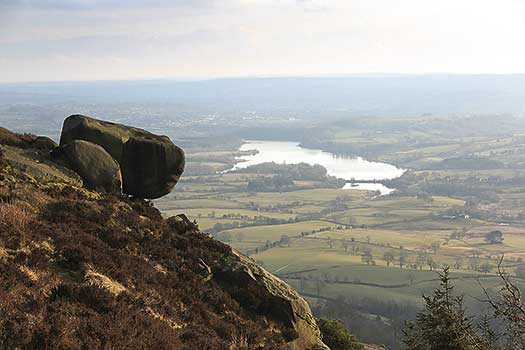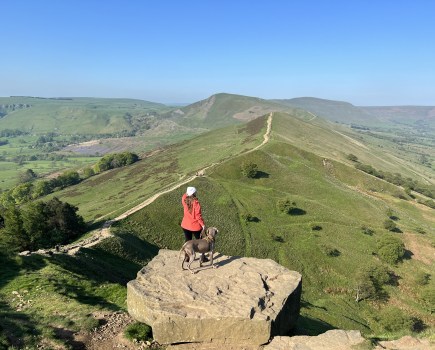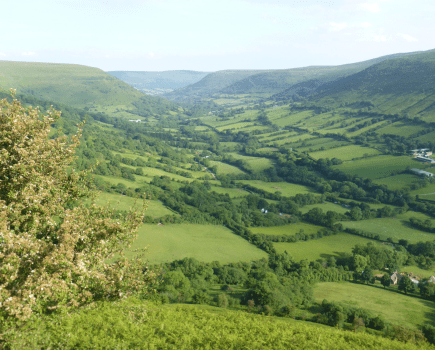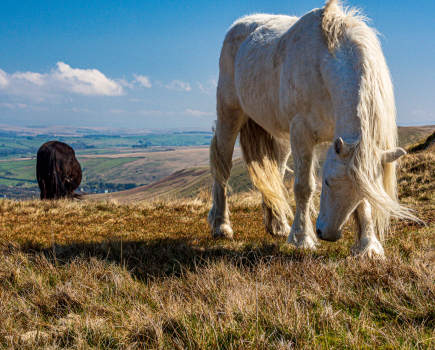Medieval poetry mixes with 1960s climbing culture on the Roaches, as Andrew Galloway discovers
Sir Gawain crept cautiously into the crypt-like chasm,
Stepping down a rough-hewn stone staircase, he stopped
to gather his thoughts; above, the gritstone gables
of this unholy church, hung with horrible lichens,
mosses, emerald moor grasses and ladies-mantles,
all as gross and as green as the giant ogre himself.
What! The silence sliced by a blood curdling sound,
the rasp of iron drawn against rough rock.
“Good Lord!” cried Gawain, the Green Knight himself,
anticipates my arrival with the honing of his axe.
Thought to have been written around 1400, the alliterative poem Sir Gawain and the Green Knight is one of the finest examples of medieval poetry in the English language. Although the author of the original text is unknown, the use of certain dialect and diction place the linguistic epicentre of the poem somewhere in the Cheshire-Staffordshire moorlands. Where, in the original text, the author writes of “rogh knokled knarres with knorned stones,” this is thought to refer to the gnarled and exposed gritstone crags of the Roaches, that stand proud above the waters of Tittesworth Reservoir to the north of the Staffordshire market town of Leek.
The magnificent Henry Moore-esque contortions of rough sandstone are famous for their association with traditional climbing and in particular with the emancipation of the sport in the 1960s, heralded most notably by Don Whillans and Joe Brown, who made the breakthrough on many new routes here. Most weekends from spring to autumn you can find modern day Gawains preparing themselves physically and mentally to do battle with the Green Knights of Sidewinder, Poisonous Python, Valkyrie.
North of the Roaches stretches the wooded whale-back ridge of Back Forest. Here, above the rushing waters of Black Brook that tumbles exuberantly into the River Dane, camouflaged among the ash and larch trees until you are practically on top of it, sits Lud’s Church, a natural chasm formed by a post-glacial landslip, that cuts into the Namurian gritstone to a depth of some 18 metres. The etymology of this mysterious place is uncertain. The steep sides of the chasm being near vertical, it is only during the days surrounding midsummer, when the sun is at its zenith, that sunlight penetrates fully into its depths.
Because of this natural phenomenon, the Celtic deity Nodens may have been worshipped here, Lud being a Cumbric derivative of his name. It is thought that worship of Nodens in this place may have lingered on in local folklore in the figure of the Green Man, an incubus of nature and landscape, of forests and hunting; a relative no doubt of the very verdant ogre whom Sir Gawain confronts in the Green Chapel: the Christian knight in mortal combat with the pagan deity in a tale of temptation, honour and exceptional bravery.
Back at Valkyrie, a climber takes a slip and decides to bail out. “Just wasn’t feeling the love today,” he says. “That first pitch – it was just too green!”
ROUTE DESCRIPTION
- Park at the layby opposite the Roaches Tea Room. There is a steep path between the two crags of Hen Cloud (may require a hand here or there), or follow the path via Roaches Hall for a more gradual ascent.
- It is worth the loss of height to descend from Hen Cloud on the path NNW to Rock Hall to see the famous climbing crags of Valkyrie, Matinee, etc.
- Just past the first large crag (Valkyrie) stone steps take you to the ‘mezzanine’ level, past more crags E then up a further flight of stone steps to the main ridge. Now walk NNW to Doxey Pool.
- Continue along the obvious path to the trig point and then on to Roaches End where you will find a section of tarmac road (and in the summer an ice cream van). Cross the road, enter the field through the stone stile turning N towards Gradbach.
- At a small stream a fingerpost directs you NW towards Lud’s Church, taking the higher path. Continue through the woods for 1.5km following fingerposts to the chasm.
- Enter the chasm with care via the stone steps from the E. Walk through the chasm and exit via the stone steps on the W side.
- Continue W towards Swythamley to the 330m spot-height (OS) by a wall where a fingerpost directs you E to Roaches End.
- At Roaches End you have a choice. You can either retrace your steps over the Roaches ridge or follow the tarmac road SSE to the layby. Sadly, the promising ‘mezzanine’ path marked by a finger post ‘Roaches Ridge (not main path)’ at SJ995644 ends at a rather high stone wall! It is access land but there are no stiles.
Medieval poetry mixes with 1960s climbing culture on the Roaches, as Andrew Galloway discovers
Sir Gawain crept cautiously into the crypt-like chasm,
Stepping down a rough-hewn stone staircase, he stopped
to gather his thoughts; above, the gritstone gables
of this unholy church, hung with horrible lichens,
mosses, emerald moor grasses and ladies-mantles,
all as gross and as green as the giant ogre himself.
What! The silence sliced by a blood curdling sound,
the rasp of iron drawn against rough rock.
“Good Lord!” cried Gawain, the Green Knight himself,
anticipates my arrival with the honing of his axe.
Thought to have been written around 1400, the alliterative poem Sir Gawain and the Green Knight is one of the finest examples of medieval poetry in the English language. Although the author of the original text is unknown, the use of certain dialect and diction place the linguistic epicentre of the poem somewhere in the Cheshire-Staffordshire moorlands. Where, in the original text, the author writes of “rogh knokled knarres with knorned stones,” this is thought to refer to the gnarled and exposed gritstone crags of the Roaches, that stand proud above the waters of Tittesworth Reservoir to the north of the Staffordshire market town of Leek.
The magnificent Henry Moore-esque contortions of rough sandstone are famous for their association with traditional climbing and in particular with the emancipation of the sport in the 1960s, heralded most notably by Don Whillans and Joe Brown, who made the breakthrough on many new routes here. Most weekends from spring to autumn you can find modern day Gawains preparing themselves physically and mentally to do battle with the Green Knights of Sidewinder, Poisonous Python, Valkyrie.
North of the Roaches stretches the wooded whale-back ridge of Back Forest. Here, above the rushing waters of Black Brook that tumbles exuberantly into the River Dane, camouflaged among the ash and larch trees until you are practically on top of it, sits Lud’s Church, a natural chasm formed by a post-glacial landslip, that cuts into the Namurian gritstone to a depth of some 18 metres. The etymology of this mysterious place is uncertain. The steep sides of the chasm being near vertical, it is only during the days surrounding midsummer, when the sun is at its zenith, that sunlight penetrates fully into its depths.
Because of this natural phenomenon, the Celtic deity Nodens may have been worshipped here, Lud being a Cumbric derivative of his name. It is thought that worship of Nodens in this place may have lingered on in local folklore in the figure of the Green Man, an incubus of nature and landscape, of forests and hunting; a relative no doubt of the very verdant ogre whom Sir Gawain confronts in the Green Chapel: the Christian knight in mortal combat with the pagan deity in a tale of temptation, honour and exceptional bravery.
Back at Valkyrie, a climber takes a slip and decides to bail out. “Just wasn’t feeling the love today,” he says. “That first pitch – it was just too green!”
ROUTE DESCRIPTION
- Park at the layby opposite the Roaches Tea Room. There is a steep path between the two crags of Hen Cloud (may require a hand here or there), or follow the path via Roaches Hall for a more gradual ascent.
- It is worth the loss of height to descend from Hen Cloud on the path NNW to Rock Hall to see the famous climbing crags of Valkyrie, Matinee, etc.
- Just past the first large crag (Valkyrie) stone steps take you to the ‘mezzanine’ level, past more crags E then up a further flight of stone steps to the main ridge. Now walk NNW to Doxey Pool.
- Continue along the obvious path to the trig point and then on to Roaches End where you will find a section of tarmac road (and in the summer an ice cream van). Cross the road, enter the field through the stone stile turning N towards Gradbach.
- At a small stream a fingerpost directs you NW towards Lud’s Church, taking the higher path. Continue through the woods for 1.5km following fingerposts to the chasm.
- Enter the chasm with care via the stone steps from the E. Walk through the chasm and exit via the stone steps on the W side.
- Continue W towards Swythamley to the 330m spot-height (OS) by a wall where a fingerpost directs you E to Roaches End.
- At Roaches End you have a choice. You can either retrace your steps over the Roaches ridge or follow the tarmac road SSE to the layby. Sadly, the promising ‘mezzanine’ path marked by a finger post ‘Roaches Ridge (not main path)’ at SJ995644 ends at a rather high stone wall! It is access land but there are no stiles.









